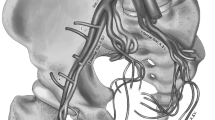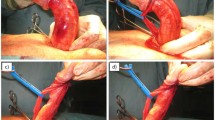Abstract
Peyronie's disease in men with satisfactory erectile function but with significant penile curvature is often treated with plaque incision or excision and grafting. The advantages and disadvantages of various grafting materials have long been debated. While artificial materials have been used, the inflammatory reaction from these grafts has produced poor results. Dermal, venous and tunica vaginalis grafts require additional operative time to harvest and their quality varies
Packaged grafts of autologous materials provide a readily available, reliable and well-tolerated choice for penile reconstruction for Peyronie's disease. These grafting materials including cadavaric pericardium, mammalian intestinal serosal products and others are easily obtained and provide a resilient yet compliant graft choice that is easy to tailor and suture in place. Host reaction is minimal and the infection risk small.
Results of Peyronie's plaque incision/excision and autologous grafting are presented and the surgical procedures employed are outlined. Excellent results can be expected in the hands of the experienced reconstructive surgeon.
This is a preview of subscription content, access via your institution
Access options
Subscribe to this journal
Receive 8 print issues and online access
$259.00 per year
only $32.38 per issue
Buy this article
- Purchase on Springer Link
- Instant access to full article PDF
Prices may be subject to local taxes which are calculated during checkout











Similar content being viewed by others
References
Carson CC . Francoise de la Peyronie (1768–1747) Invest Urol. 1981 29: 62–63
Schwarzer U et al. Prevalence of Peyronie's disease: results of an 8000 man survey J Urol 2000 163: (Suppl) 167A
Lyles KW et al. Peyronie's disease is associated with Paget's disease of bone J Bone Min Res 1997 12: 929–934
Gelbard MK, Dorey F, James K . The natural history of Peyronie's disease J Urol 1999 144: 1376–1381
Carson CC, Mulcahy JJ, Govier FE . Penile prosthesis and Peyronie's disease J Urol 2000 164: 378–380
Nesbit RM . Congenital curvature of the phallus: a report of three cases with description of correction operation J Urol 1965 93: 230
Coughlin PWF, Cannon CC, Paulsand . Nesbit procedure for the correction of penile curvature and peyronie's disease J Urol 1984 131: 282–285
Devine CJ Jr, Horton CE . Surgical treatment of Peyronie's disease with dermal graft J Urol 1974 111: 44–46
Wild RM, Devine CJ, Horton CE . Dermal graft repair of Peyronie's disease: survey of 50 patients J Urol 1979 121: 47
Lue TF, El-Sakka AI . Venous patch graft for Peyronie's disease. Part I: Technique J Urol 1998 160: 2047
Gelbard MK, Hayden B . Expanding contractures of the tunica albuginea due to Peyronie's disease with temporalis Fascia free grafts J Urol 1991 145: 772
Carson CC et al. Symposium on Peyronie's disease Int J Impot Res 1998 10: 121–122
Lowsley OS, Boyce WH . Further experiences with an operation for the cure of Peyronie's disease J Urol 1950 63: 888
Carson CC . Peyronie's disease: etiology diagnosis and treatment In: Mulcahy JJ, ed Diagnosis and management of male sexual dysfunction Igagu-Shoin 1997 pp 164–181
Collins JP . Experience with lyophilized human dura for treatment of Peyronie's disease Urology 1988 31: 379
Hellstrom WJ, Reddy S . Application of pericardial grafts in the surgical treatment of Peyronie's disease J Urol 2000 163: 1445
Chun JL, McGregor A, Krishnan R, Carson CC . A comparison of dermal and cadaveric pericardial graft in the modified Horton–Devine procedure for Peyronie's disease J Urol (in press)
Leungwattanakij S, Caulfield J, Bivalacqua T, Hellstrom WJ . Evaluation of cadaveric pericardium in the treatment of Peyronie's disease using a rat model J Urol 2000 163: (Suppl) 233A
Bruschini H, Mitre A . Peyronie's disease: surgical treatment with muscular aponeurosis Urology 1979 13: 505
Singla AJ . Choice of sling materials for the treatment of intrinsic sphincter dysfunction in women Contemp Urol 2000 12: 189–204
Burnett AL . Fascialata in penile reconstruction surgery: an reappraisal of the fascia lata graft Plastic Recon Surg 1997 99: 1061
Knoll LD . Use of porcine small intestinal submucosal-graft in the surgical management of Peyronie's disease Urology 2000 57: 753–757
Author information
Authors and Affiliations
Rights and permissions
About this article
Cite this article
Carson, C., Chun, J. Peyronie's disease: surgical management: autologous materials. Int J Impot Res 14, 329–335 (2002). https://doi.org/10.1038/sj.ijir.3900864
Published:
Issue Date:
DOI: https://doi.org/10.1038/sj.ijir.3900864
Keywords
This article is cited by
-
Biomaterial Grafting Materials in Peyronie’s Disease
Current Sexual Health Reports (2015)
-
Surgical Management of Peyronie’s Disease
Current Urology Reports (2014)
-
Medium-term follow-up of plaque incision and porcine small intestinal submucosal grafting for Peyronie's disease
International Journal of Impotence Research (2010)
-
Sensory changes after surgical correction of penile curvature
International Journal of Impotence Research (2009)
-
Preputial graft in penile curvature correction: preliminary results
International Journal of Impotence Research (2009)



